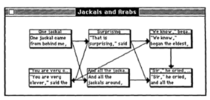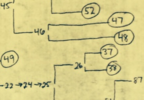


He later worked with Andries van Dam to develop the Hypertext Editing System (text editing) in 1967 at Brown University. In 1963, Ted Nelson coined the terms 'hypertext' and 'hypermedia' as part of a model he developed for creating and using linked content (first published reference 1965). Ted Nelson gives a presentation on Project Xanadu, a theoretical hypertext model conceived in the 1960s whose first and incomplete implementation was first published in 1998. Because the Memex was never implemented and could only link content in a relatively crude fashion - by creating chains of entire microfilm frames - the Memex is now regarded only as a proto-hypertext device, but it is fundamental to the history of hypertext because it directly inspired the invention of hypertext by Ted Nelson and Douglas Engelbart. The coded symbols would enable the Memex to index, search, and link content to create and follow associative trails. A Memex would hypothetically store - and record - content on reels of microfilm, using electric photocells to read coded symbols recorded next to individual microfilm frames while the reels spun at high speed, and stopping on command. In 1945, Vannevar Bush wrote an article in The Atlantic Monthly called "As We May Think", about a futuristic proto-hypertext device he called a Memex. In 1941, Jorge Luis Borges published "The Garden of Forking Paths", a short story that is often considered an inspiration for the concept of hypertext. Main articles: History of hypertext and Timeline of hypertext technology The most famous implementation of hypertext is the World Wide Web, written in the final months of 1990 and released on the Internet in 1991. Hypertext can be used to support very complex and dynamic systems of linking and cross-referencing. Some implementations support transclusion, where text or other content is included by reference and automatically rendered in place. A lesser known feature is StretchText, which expands or contracts the content in place, thereby giving more control to the reader in determining the level of detail of the displayed document. Links used in a hypertext document usually replace the current piece of hypertext with the destination document. A well-constructed system can also incorporate other user-interface conventions, such as menus and command lines.
STORYSPACE NODES SOFTWARE
Static hypertext can be used to cross-reference collections of data in documents, software applications, or books on CDs. Hypertext documents can either be static (prepared and stored in advance) or dynamic (continually changing in response to user input, such as dynamic web pages).


 0 kommentar(er)
0 kommentar(er)
